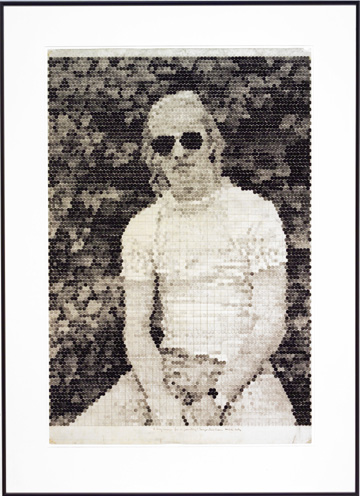 Click here to read an essay by Robert Epp. Click here to read an essay by Dr. Jeanne Randolph. Click here to read an essay by Cliff Eyland. Click here to see a list of works in the exhibition. Click here to view images of Gordon Lebredt's work. Click here for a commentary by Robert Epp on Gordon Lebredt's "white walls:black holes" Click here for an addendum by Gordon Lebredt on his "white walls:black holes" Click here for images by Gordon Lebredt from "white walls:black holes"
|
<  >
>ABOVE: Gordon Lebredt, Dot drawing. Photo credit: Ernest Mayer. (Note: To navigate please click arrows or image.) 01 Dot drawing c. 1976 graphite on paper 112.5 x 77.0 cm Collection of the Canada Council Art Bank, Ottawa (76/7-0466) Lebredt: “Based on an analogue photograph, this rather crude 'digitized' drawing was produced by pushing differing amounts of powdered graphite through a circular hole in a clear acetate template. The template could be moved horizontally following a narrow slot cut in a second plate which, in turn, could be adjusted vertically in relation to the inscription surface positioned directly beneath it. Thus, the more or less blind results were obtained by means of a raster-like movement analogous to that which generates an on-screen video image.” In the November 1973 issue of Scientific American magazine, Bell Labs researcher Leon D. Harmon published an article titled “The Recognition of Faces.”1 According to Lebredt it was Harmon's article concerning facial recognition and using extremely low resolution, computer generated images that influenced his work in the years just before graduation from art school. Harmon's article details his experiments with the “threshold” of face recognition. One approach he takes is to see “how little information ... in the form of 'bits,' or binary digits, is required to pictorially represent a face....”2 In the experiment Harmon scans a 35 mm transparency of a conventional portrait photograph of President Abraham Lincoln using a beam of light moving in a raster pattern. The result is a “reduced-information-content portrait” or “block portrait”3 arranged in a ratio of 16 x 16 squares.4 Lebredt's Dot drawing mimics Harmon's raster pattern or horizontal scanning to create the composition. Like Harmon's block portrait of Lincoln, Lebredt's drawing plays with the threshold of facial recognition, by requiring the viewer to find the correct viewing distance from the drawing to “read” the graphite dots as a figure. 1. Leon D. Harmon, “The Recognition of Faces,” Scientific American, November 1973, vol. 229, no. 5, pp 71-82. 2. Harmon, p. 72. 3. See http://www.barcodeart.com/art/other/president/history/. 4. Harmon, p. 73. |